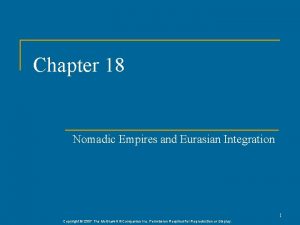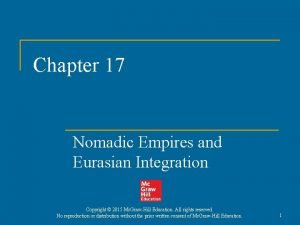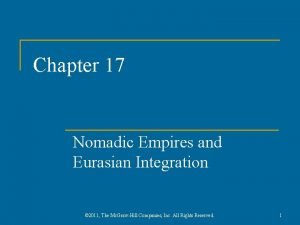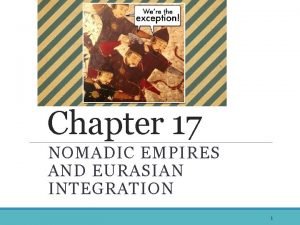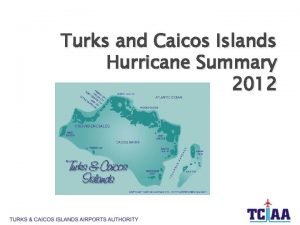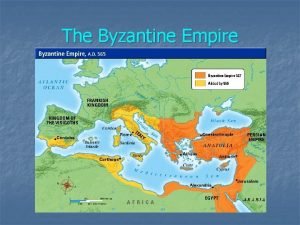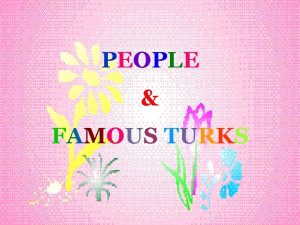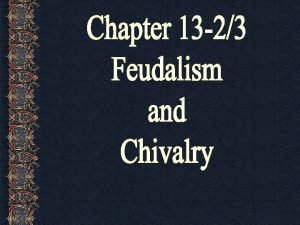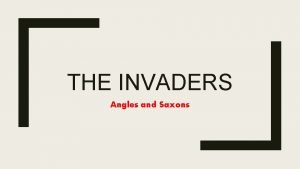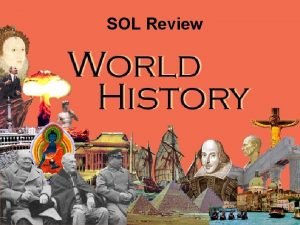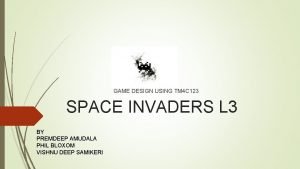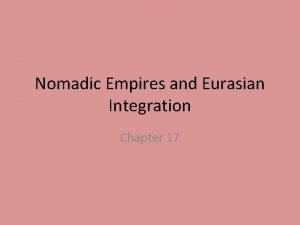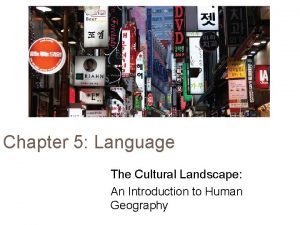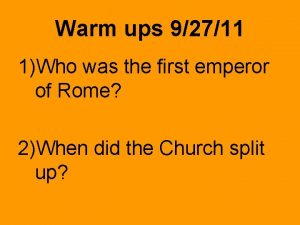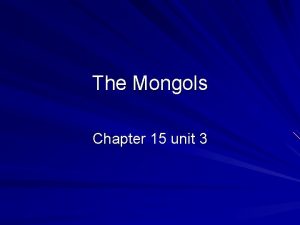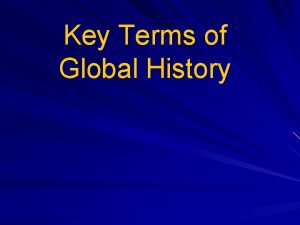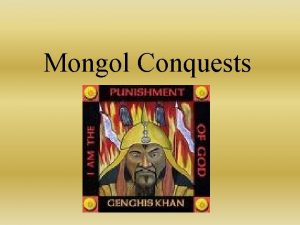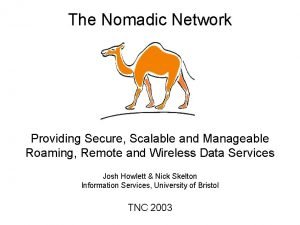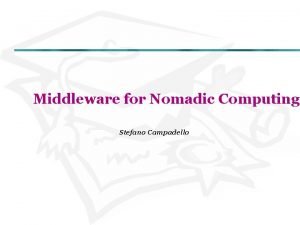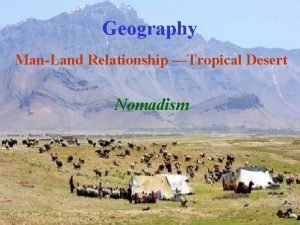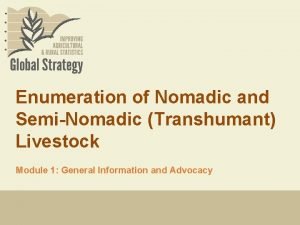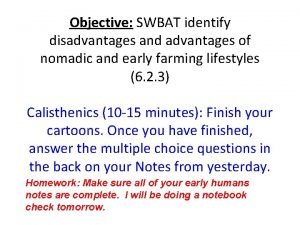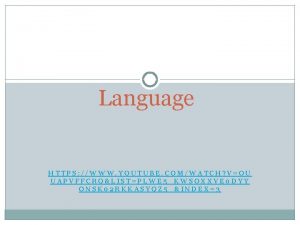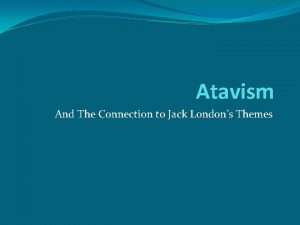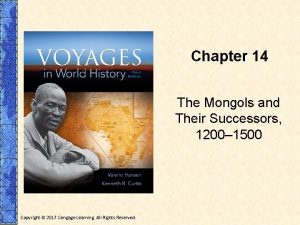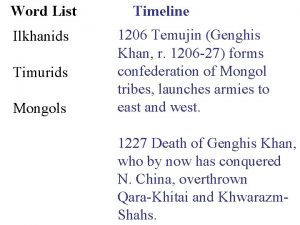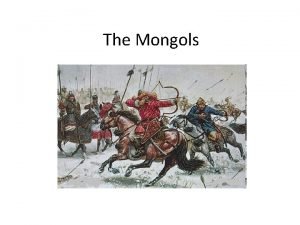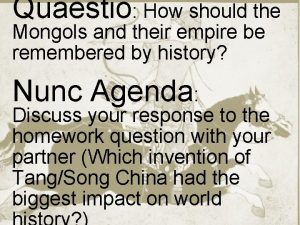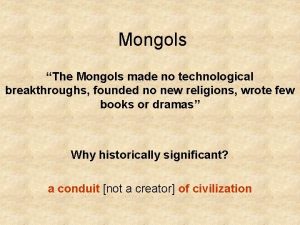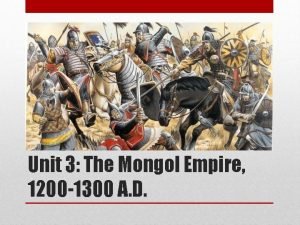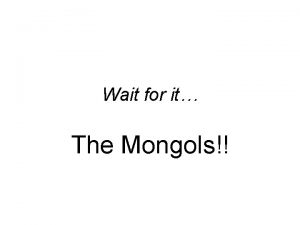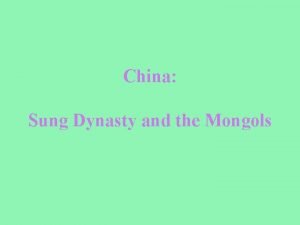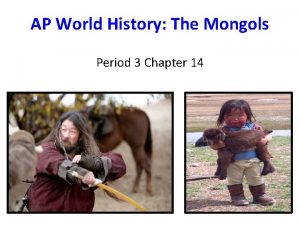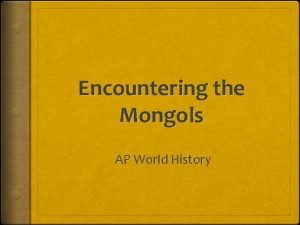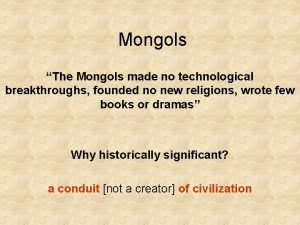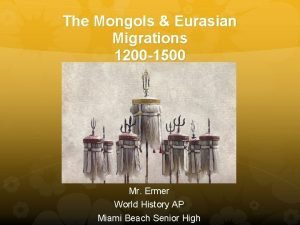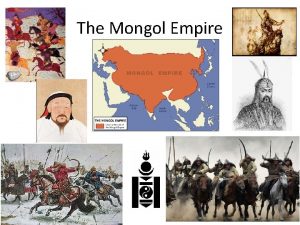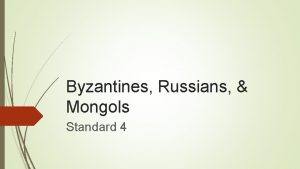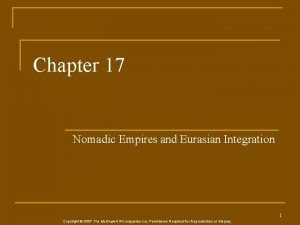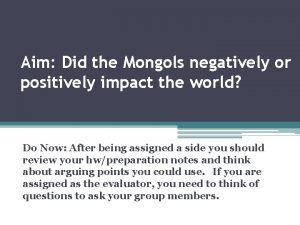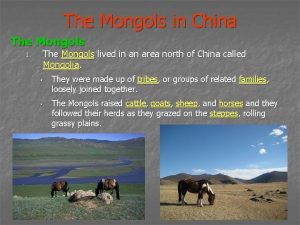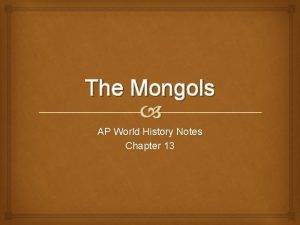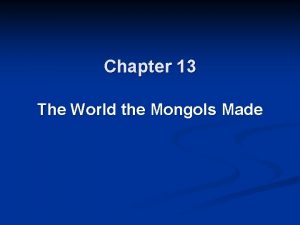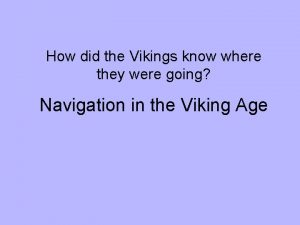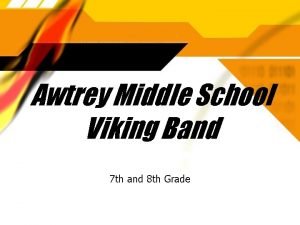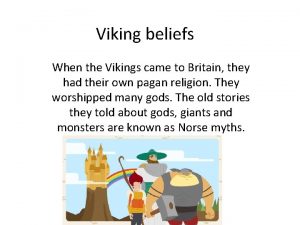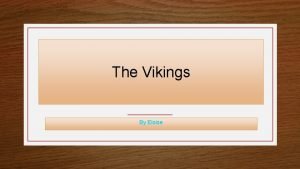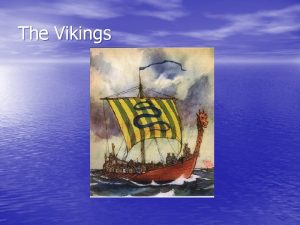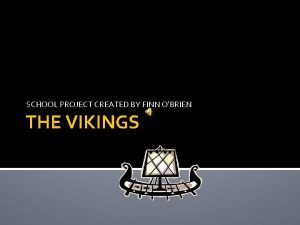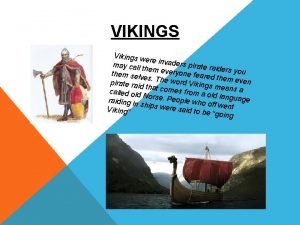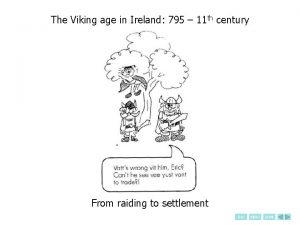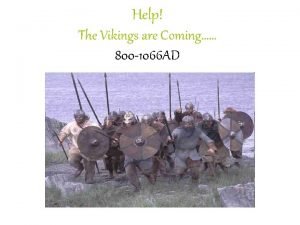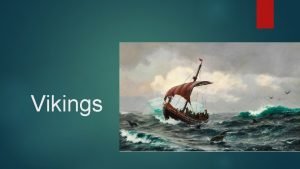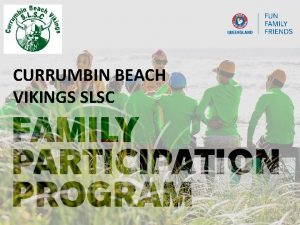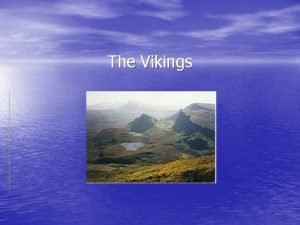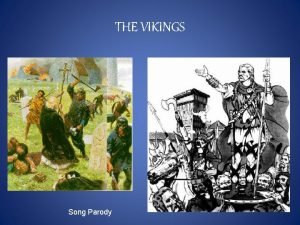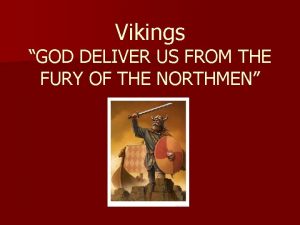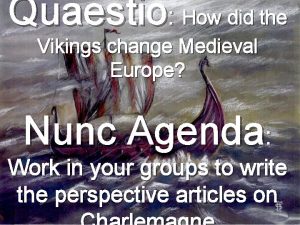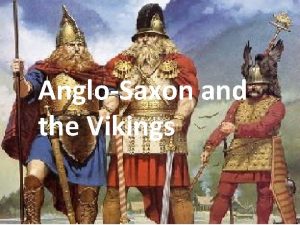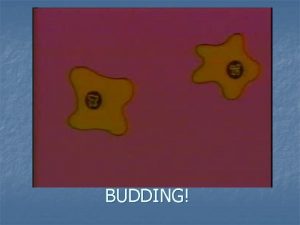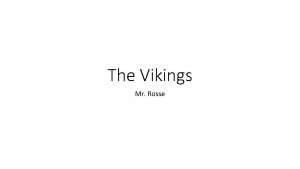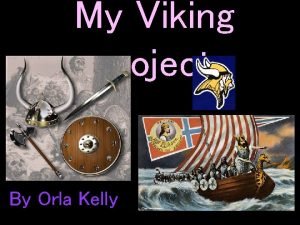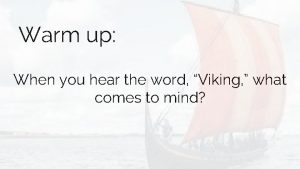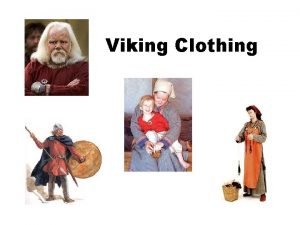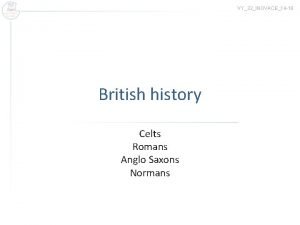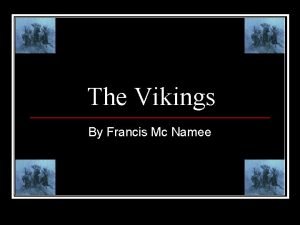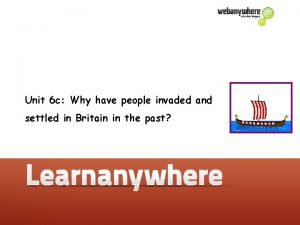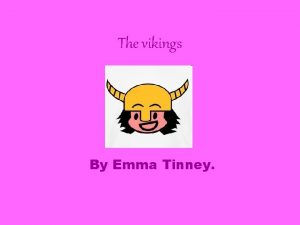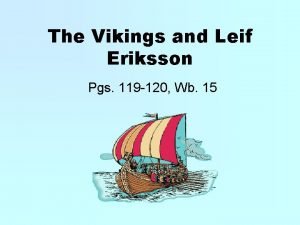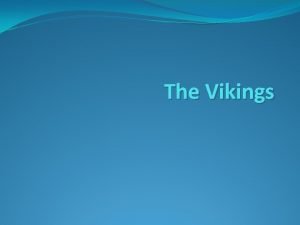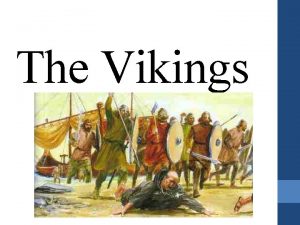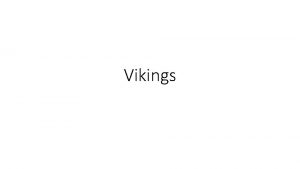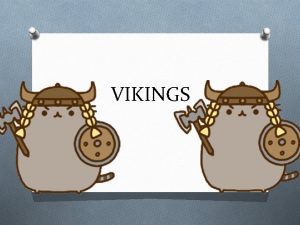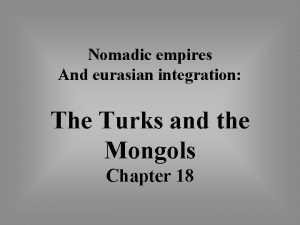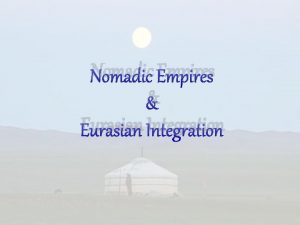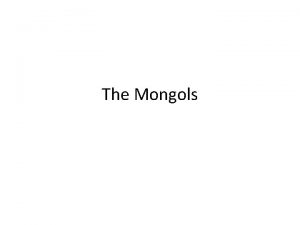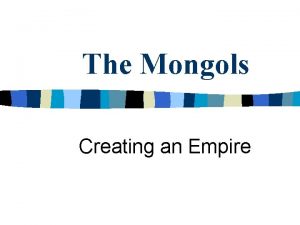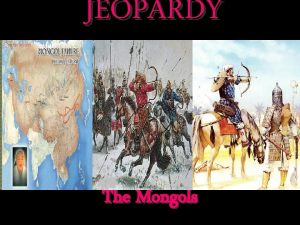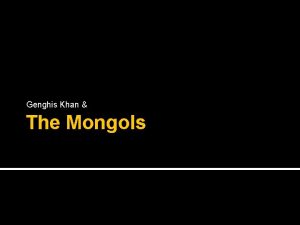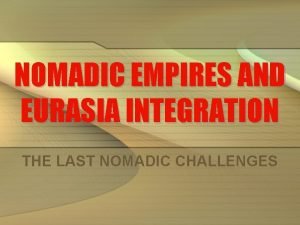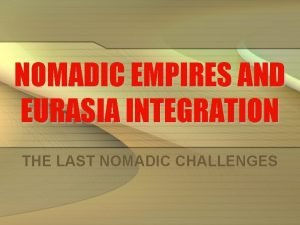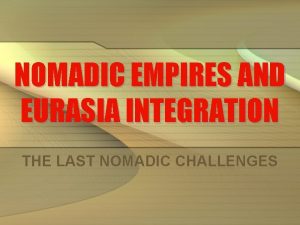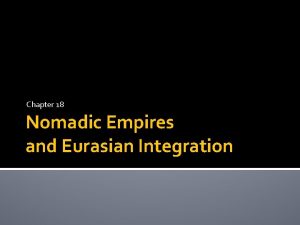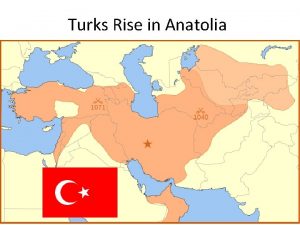Nomadic Invaders Empires Vikings Turks Mongols A journey





















































































- Slides: 85

Nomadic Invaders & Empires Vikings Turks Mongols

A journey through time

The Way of the Vikings

Vikings - Exploration n The Vikings travelled to many countries in Europe and Asia They explored and traded with the peoples of these countries They settled in England, Scotland Ireland

Vikings - The Beginning n n n Vikings lived over one thousand years ago They originally lived in Norway, Sweden and Denmark They were a great seafaring people They explored and traded with the peoples of Europe They settled in England, Scotland Iceland

How did Vikings travel ? The Vikings used different types of ships. n For fishing - These boats were small shallow vessels which were used to catch fish in rivers, lakes and fjords n For trading - These heavy ships or knorrs were trading vessels used for carrying cargo to trade with other countries

BY DAVID EBONG An ahistorical depiction of a Viking

Viking - Longships n n These longships or warships often had a dragon’s head carved on the prow to scare the enemy. Each boat could hold 50 -60 warriors and were so fast and quiet in the water, their enemies were often taken by surprise !

Viking Ships in the Bayeux Tapestry Take a look at the shields on the red boat above. Vikings mounted their shields on th of their ships when not rowing (They got in the way of the oars).

The “Old Norse” n n n Scandinavian raiders from Denmark, Norway and Sweden Spoke a common language Most active during the “Viking Age” from 790 -1100 A. D.

Beginnings of Invasion n A booming population and poor cropland forced the Vikings to look for other ways of support. n The first recorded Viking raid in England was at the monastery at Lindisfarne in 793 A. D. n Favorable winds and fast, seaworthy ships with shallow draft made Viking raiders very successful.

What were their goals? • Raids and loot were not the whole story of the Vikings. Land to farm was also a commodity. There were limited sources of food. • They received influences from Europe that they saw as technologically and politically superior to their culture. Unlike many other invaders in history, the vikings weren’t trying to spread their religion that was paganism, rather gain new resources and new connections. They wanted political and economical advantage. • They had to find food, live off the land, and set up shop. They drove people out and took their money and other valuables they had. Vikings targeted the church and monasteries, which were the major sources of wealth at the time. An accurate depiction of what a Viking looked like.

Offensive Weapons • The main offensive weapons were the spear, sword, and battle-axe. • They carried weapons not just for battle but also as a symbol of their owners’ class and wealth. Weapons were decorated with inlays, twisted wire and other accessories in silver, copper, and bronze. • The spear was the common weapon with an iron blade 2 m to 3 m in length. • Swords were a sign of high status because they were costly to make. The blades were usually double edged and up to 90 cm. Many swords were given names.

Defensive Weapons • There were circular shields up to one meter across that were carried. The shield may have been leather covered. Around 1000, the kite shaped shield was introduced to the Vikings to provide more protection for the legs. • It was essential to wear thick padding underneath to absorb the force of blows or arrow strikes. Reindeer hide was used as armor. An accurate viking helmet left. The mail armor shown • They used long tunics of mail armor right. reaching below the waist. They were not very protective. It took many hours to produce a shirt, making it very expensive. It’s likely they were worn more by leaders. • Helmets were probably worn by leaders as well. Horned helmets also took great skill to produce. A modern myth!!!

Vikings and England n n n More important things to know about Vikings in this period: “According to the Anglo-Saxon Chronicle, compiled about 891, the first Viking raids against Engand occured in the year 787. The most infamous of these early raids was the Danish attack at Lindesfarne in 793. This momentous event, we read in the Anglo-Saxon Chronicle, was presaged by terrible omens, including flashes of lightning and fiery dragons seen flying through the air. ” (http: //www. pitt. edu/~dash/ships. html) Towns ending with –by have Viking origins. Vikings also were the settlers of York. The English had to pay “danegeld” in order to keep the Vikings from pushing further into English lands. The “Dane Law” helped to end the constant bloodshed between the two factions.

More on Viking Tactics n Amphibious Landing At Pevensey

The Shield-Wall Utilizing spears and shields in unison. Very effective at handling cavalry. Like riding into a porcupine. n

A Noble Fate n n n To die in battle was the noblest fate. They were fiercely loyal to their own clans. Raiding was a respectable way of life. In 1066 at the Battle of Stamford Bridge a Viking army led by Harald Hardrada was defeated by Harold Godwinson of England who a few weeks later was in turn beaten by William of Normandy (himself a Viking descendant) at the Battle of Hastings. William proclaimed himself King of England. Changing history and thus ending the Viking era.

Conquest and Settlement n Began staying in the lands they pillaged including: n England France Ireland Scotland n n n n It beat going back home all the time! Explored other places including: Greenland Iceland Labrador

Viking Raids n n n People lived in constant fear of the Vikings. Fast- moving ships allowed the Vikings to approach quickly. Favorite targets were monasteries.

Viking Settlements n Some Vikings settled down and established permanent settlements. n n n Settled in Iceland in late 700 s. The Vikings under Leif Eriksson reached North America. Led by a chief named Rollo the Vikings settled in northern France.

Conquests • The first Viking raids were hit- and -run affairs. There was no coordination and long term plan behind them. The Vikings would later have more powerful forays and would have base camps where they would spend the winter. • Vikings raided the British Isles and the Western portions of the Carolingian Empire in France. They conquered much of Northern England in the 9 th century, and they established a kingdom in Ireland. • In return for cash Vikings negotiated peaceful coexistence and conversion to whomever they attacked. Some leaders paid ransom to Viking armies. • In 911 AD Charles III of France gave Normandy (“French for territory of Norsemen”) to the Viking leader Rollos who became a Christian. Vikings helped adopt the French language and organized a strong state in Normandy. • During the same century a Norman adventurer Robert Guiscard created the Norman kingdom of Sicily. (continued) Maximum extent of the islamic conquests, 7 th 11 th centuries (Green). Areas ruled by the Vikings or Normans, 9 th - 12 th centuries (Brown). Carolingian Empire at the death of Charlemagne in 814 (Grey)

What happened to the Vikings? n n n Vikings became citizens of many places in Europe. Many had become Christians back in their homelands. This lead to the downfall of the Norse religion and culture. Kings instituted taxes and the economy changed so that you could get along better off as a trader than a raider. The Viking invasions caused European kingdoms to be more centralized and focused. European kingdoms learned how to protect themselves and gain by trading and negotiating with the Vikings instead of battling them. The Viking end

The Viking’s Impact n n Many styles of the Viking ships were adopted by other European powers. The jury of English common law was a an outgrowth of Viking ideas about community obligations and sworn investigations. Signs of Viking influence are found in languages, vocabulary, and place-names of the areas they settled. They had an impact on medieval technology and trade, and was an important part of Europe’s development.

The Rise of the Mongols 25

The Mongols

Geography of the Steppe n n temperature changes can be extreme in Mongolia - ranges from – 57°F in winter to 96°F in the summer

The Steppes are grasslands in Central Asia. 30

The Mongol empires about 1300 C. E.

Nomadism in Central Asia n Resources n n Scarce water>>conflicts>>extermination of smaller groups>>in formation of alliances and Around 1000 less water and pressure for tribes to move out to find new sources n Hierarchical n n organization Headed by single leader or Khan’s decision had to be ratified by a council of leaders of powerful families Power groups demanded and received tribute in the form of slaves and goods Some lived entirely on tribute

Nomadism in Central Asia n Complex n n The groups /families formed larger groups called federations Women important in negotiating alliances n Seasonal n n n federations migrations and religious contacts Brought into contact w/: Manichaeism, Judaism, Christianity, Buddhism, & Islam Religously tolerant Khan thought to represent the sky god who transcended cultures and religions and seen as universal rulers above individual religs. & used religs. of their subjects

Nomadic Economy and Society n n Rainfall in central Asia too little to support large-scale agriculture Grazing animals thrive, central Asians turn to animal herding n n n Food Clothing Shelter (yurts) Migratory patterns to follow pastureland Small-scale farming, rudimentary artisanry 34

Nomadism in Central Asia n Economic n n n Self sufficiency This was an ideal that they strove for Yet always relied on trade w/settled people When normal trade relations interrupted, nomads made war on agriculturalists

1. herd domesticated animals 4. battle other nomadic groups over grassland water rights 6. depend on your animals for food, clothing, and housing 2. constantly move, searching for good pasture to feed your herds Eight Ways to Live the Life of a Steppe Nomad 7. wear clothing made of skins and wool, and live in portable felt tents called yurts 3. follow a familiar seasonal pattern and returned on a regular basis to the same campsites 5. live on horseback as you follow your huge herds over the steppe 8. traveled together in kinship groups or clans

Traditional Yurt

The Mongol Empire n The Mongols as Rulers n n invaded areas never recovered populations of some cities wiped out



The Four Khanates n 1260 - four khanates, each ruled by a descendant of Genghis Khan n The Khanate of the Great Khan n n The Khanate of Chaghatai n n Central Asia The Ilkhanate n n Mongolia and China Persia The Khanate of the Golden Horde n Russia


The Mongol empires about 1300 C. E.

The Rise of the Mongols n Genghis Khan n n n 1206 military organizer gifted strategist used tricks to confuse his enemy used spies to identify enemy weaknesses adopted new weapons and technologies used by his enemies believed in terrifying his enemies into surrender

Chinggis Khan (1167 -1227) and the Making of the Mongol Empire n n n Temüjin, b. 1167 Father prominent warrior, poisoned c. 1177, forced into poverty Mastered steppe diplomacy, elimination of enemies Brought all Mongol tribes into one confederation 1206 proclaimed Chinggis Khan: “Universal Ruler” 45

Chinggis Khan n The four most significant legacies of Chinggis Khan are: • his tolerance of many religions • his creation of the Mongols' first script • his support for trade and crafts • his creation of a legal code specific to the Mongols' pastoral-nomadic way of life

The Mongol Peace “Pax Mongolia” n n mid-1200 s to mid-1300 s imposed stability, law

The Mongol Peace n n mid-1200 s to mid-1300 s imposed stability, law and order across much of Eurasia

Positive Effects of Mongol Rule n guaranteed safe passage of trade caravans, travelers, and missionaries from one end of the empire to another trade between Europe and Asia increased n new ideas and inventions spread Positive Effects of Mongol Rule n

Positive Effects of Mongol Rule

Dynasties of China, 500 -1400

Mongol Conquests

Mongol conquests n n 1206 -1258 conquered form Korea to Hungary and Baghdad Ability to conquer based on: n n n Horsemanship Better bows Following a volley of arrows w/ deadly cavalry Willing and actually adopting new military techniques Adopt new military technology Incorporate non Mongol soldiers into their armies

Mongol Conquests continued n Reputation for slaughtering all who wouldn’t surrender n n (kind of makes them the world’s first tactical terrorists) Ability to take advantage of rivalry among enemies

Mongol Arms n Mongol population only 1 million (less than 1% of Chinese population) n n Army c. 100 -125, 000 Strengths: Cavalry n Short bows n Rewarded enemies who surrender, cruel to enemies who fight 55 n

Mongol Conquests Conquest of China by 1220 n Conquest of Afghanistan, Persia n n n emissaries murdered, following year Chinggis Khan destroys ruler Ravaged lands to prevent future rebellions n Large-scale, long-term devastation 56

Mongol attack on the Khwarezmian Empire n n In 1218, Genghis Khan sent ambassadors and a 500 man caravan to establish relations with the shah of the Muslim empire of Khwarezmia. Rather than treat the Mongols as equals, the caravan was slaughtered at the city of Otrar. Genghis Khan sent special ambassadors to the shah in order to explain the situation – the shah had all but one of the ambassadors beheaded. 200, 000 Mongols marched on the Khwarezmian Empire

The city of Otrar was taken and the governor who had attacked the initial caravan was executed by having molten silver poured into his eyes and ears. n Mongol numbers, brutality and internal Khwarezmian problems – all led to the Mongol conquest of the empire in 1220. n

Overland trade and the Plague Mongol conquests {SIGNIFICANCE} opened overland trade routes and n Never before seen commercial integration in Eurasia n Long distance trade led to cross diffusion of military and scientific between Europe M. E. , China, Japan, Iran n

Overland trade and the Plague n Diseases e. g. Bubonic plague spread over trade routes of Mongol empire Lingered in Yunan (Southwest) China n Transferred to north China and Central Asia n From Kaffa and from there to the Mediterranean world n

Plague spreads from Kaffa

Origin and speed of Plague

Questions to Consider n n What factors made the Mongols able to conquer and maintain their hold on such a large amount of territory? How did the effects of Mongol domination differ in Russia and in the Muslim Lands? How were they similar? Why did trade, science and technology flourish under the Mongols? What does the text mean when it talks about “regional definition? ” What is the relationship between Mongol rule and regional definition?

The Golden Horde n Conquest of Russia, 1237 -1241 Established tributary relationship to 15 th century n Rule over Crimea to late 18 th century n n Raids into Poland, Hungary, Germany 64

The Ilkhanate of Persia Abbasid empire toppled n Baghdad sacked, 1258 n n n 200, 000 massacred Expansion into Syria checked by Egyptian forces 65

In addition to Mongol conquests, reasons for success in Iran and Russia Use of Genghis Khan’s principle of adaptability and inclusiveness n Changed techniques for penetrating sophisticated fortifications: n Hurling large projectiles on fire n Adapted a more sophisticated design from the Kwarazmshahs near Smarkand in Central Asia and then used on the people Iraq and Iran. n

In addition to Mongol conquests slide reasons for success in Iran and Russia #2 • Either slaughter or slow starvation if they failed to surrender vs. • offering their prospective victims food, shelter and protection if they surrendered without a fight • Terrible bloodletting at Balkh, Afghanistan served as model to warn all those who wouldn’t surrender • Many middle eastern cities were wiling to accept life instead of destruction

Mongol Success continued #3 n n n In cities of central Asia, they exploited rivalries between Muslims and nonbelievers In the Middle East w/ Mongol majority Mongols exploited Christian resentment of Muslim rule in their seizure of cities in Syria forcing conversion of mosques to churches In capturing Baghdad in 1258 Hulegu put people in important posts at the request of his Christian wife

Impact of Mongol Rule n n n Russian cultural center moved from Kiev to Moscow. Mongol armies invaded Europe and reached Vienna. Europeans opened up trade relations with the Mongols. Bubonic Plague spread throughout Europe and Asia. Ottoman Turks took over Constantinople and renamed it Istanbul in 1453. Mamluks resisted the Mongols in Egypt.

Kublai Khan n 1215 -1294 Grandson of Genghis Khan – succession battle between him and a brother led to the end of a united Mongol Empire Kublai established control of the Chinese lands of the Mongol Empire and established the YUAN DYNASTY.

Yuan Dynasty 1271 -1368 n n n Kublai Khan claimed rights over Mongol territories far west – and used the title khan – but his descendants did not press such claims and used the title Emperor of China Perhaps initially fearful of loosing China, in the early days of the Yuan Dynasty, the Mongols plundered widely – but recognized the money found through trade and encouraged the use of the Silk Road and the transfer of Chinese technology west. It was during his reign that the Italian Marco Polo visited China.

n n n Attempts by the Mongol Yuan to integrate with the Han Chinese proved to be ineffective. Weak Yuan emperors and a belief by other Mongols that the Yuan had become Chinese (something the Han Chinese disputed) led to the downfall of the dynasty. The dynasty was eventually forced from its capital (Beijing) by the Ming Dynasty. Remnants of the Yuan moved north and established a weak Northern Yuan kingdom – eventually controlled by the Manchu.

n Impact of the Mongol Yuan on China: Development of drama, novels and the written vernacular n Re-establishment of Confucian government policies as a way to unite China n Religious toleration n Advances in science and the continued development of the Grand Canal n Transfer of information and trade with the west n

Decline of the Yuan Dynasty in China n n n Mongols spend bullion that supported paper currency Public loses confidence in paper money, prices rise From 1320 s, major power struggles Bubonic plague spreads 1330 -1340 s 1368 Mongols flee peasant rebellion 74

Nomadic Economy and Society n n Rainfall in central Asia too little to support large-scale agriculture Grazing animals thrive, central Asians turn to animal herding n n n Food Clothing Shelter (yurts) Migratory patterns to follow pastureland Small-scale farming, rudimentary artisanry 75

Nomads in Turkmenistan 76

Nomadic Economy Trade links between nomadic and sedentary peoples n Nomads engage in long-distance travel n n Caravan routes 77

Nomadic Society n n n Governance basically clan-based Charismatic individuals become nobles, occasionally assert authority Unusually fluid status for nobility n n Hereditary, but could be lost through incompetence Advancement for meritorious non-nobles 78

Nomadic Religion n n Shamans center of pagan worship Appeal of Buddhism, Nestorian Christianity, Islam, Manichaeism from 6 th century CE Turkish script developed, partially to record religious teachings Conversion to Islam in 10 th century due to Abbasid influence 79

Military Organization Large confederations under a khan n Authority extended through tribal elders n Exceptionally strong cavalries n Mobility n Speed n 80

Turkish empires and their neighbors about 1210 C. E 81

Turkish empires and their neighbors about 1210 C. E

Tamerlane's empire about 1405 C. E. .

Saljuq Turks and the Abbasid Empire n 8 -10 th centuries Turkish peoples on border of Abbasid empire n Service in Abbasid armies Eventually came to dominate Abbasid caliphs n 1055 Saljuq leader named Sultan, caliphs remain figureheads n 84

Saljuq Turks and the Byzantine Empire 1071 Saljuqs defeat Byzantine army, take emperor captive n Large-scale invasion of Anatolia n Many conversions to Islam n Ottoman Turks conquer Constantinople 1453 n 85

Tamerlane the Conquerer (c. 13361405) n Turkish conqueror Timur n Timur the Lame: Tamerlane United Turkish nomads in Khanate of Chaghatai –(former Persian Empire) n Major military campaigns n n Built capital in Samarkand 86

Tamerlane’s Heirs Poor organization of governing structure – Like Genghis Kahn, was a conqueror not an administrator n Power struggles divide empire into four n Yet heavily influenced several empires: n Mughal n Safavid n Ottoman n 87
 Vikings and mongols
Vikings and mongols Chapter 18 nomadic empires and eurasian integration
Chapter 18 nomadic empires and eurasian integration Chapter 17 nomadic empires and eurasian integration
Chapter 17 nomadic empires and eurasian integration Chapter 17 nomadic empires and eurasian integration
Chapter 17 nomadic empires and eurasian integration Chapter 17 nomadic empires and eurasian integration
Chapter 17 nomadic empires and eurasian integration How are maritime and land based empires similar
How are maritime and land based empires similar Turks and caicos hurricane season
Turks and caicos hurricane season Turks fluid colour
Turks fluid colour Constantinople
Constantinople Famous turks
Famous turks Invaders attack western europe
Invaders attack western europe Vertical angles
Vertical angles Where did invaders typically enter india from
Where did invaders typically enter india from Scratch space invaders
Scratch space invaders Space invaders flowchart
Space invaders flowchart Islamic jeopardy questions
Islamic jeopardy questions Nomadic religion
Nomadic religion The nomadic network
The nomadic network Nomadic warrior theory
Nomadic warrior theory What was the nomadic lifestyle
What was the nomadic lifestyle Chapter 15 the last great nomadic challenges
Chapter 15 the last great nomadic challenges What is dharma
What is dharma Asian massage mongol
Asian massage mongol Nomadic network
Nomadic network Nomadic computing
Nomadic computing Nomadic herding definition ap human geography
Nomadic herding definition ap human geography Gsars
Gsars Nomadic user disebut juga
Nomadic user disebut juga Advantages and disadvantages of nomadic farming
Advantages and disadvantages of nomadic farming Nomadic warrior theory
Nomadic warrior theory Old longings nomadic leap
Old longings nomadic leap Wait for it the mongols
Wait for it the mongols Cengage
Cengage Timurid tile
Timurid tile Kulbai khan
Kulbai khan The mongols in world history webquest
The mongols in world history webquest How should the mongols be remembered
How should the mongols be remembered The mongols made no technological breakthroughs
The mongols made no technological breakthroughs What did the mongols do for the silk road
What did the mongols do for the silk road Wait for it the mongols
Wait for it the mongols Sung dynasty art
Sung dynasty art The mongols in world history
The mongols in world history Encountering the mongols comparing three cases
Encountering the mongols comparing three cases Mongols in russia ap world history
Mongols in russia ap world history Mongolian diet meme
Mongolian diet meme Mongols miami
Mongols miami Genghis real name
Genghis real name Byzantines vs mongols
Byzantines vs mongols The mongols in world history
The mongols in world history Tughril
Tughril How did the mongols positively impact the world
How did the mongols positively impact the world Where did kublai khan build palaces
Where did kublai khan build palaces Temujin ap world history
Temujin ap world history Mongols chapter 13
Mongols chapter 13 How did the vikings know where they were going
How did the vikings know where they were going Where did the vikings originate from
Where did the vikings originate from Viking doc band
Viking doc band Vikings beliefs
Vikings beliefs Vikings region
Vikings region Who were the vikings and where did they come from
Who were the vikings and where did they come from Vikings map
Vikings map Vikings school project
Vikings school project Pirate bay vikings
Pirate bay vikings In914a
In914a Danelaw area
Danelaw area Where did vikings originate from
Where did vikings originate from Vikings slsc
Vikings slsc Scandinavian explorers
Scandinavian explorers San francisco vikings
San francisco vikings Viking love song
Viking love song From the fury of the northmen deliver us
From the fury of the northmen deliver us Vikings sack paris
Vikings sack paris “how did the vikings change medieval europe?”
“how did the vikings change medieval europe?” Anglo saxon days of the week
Anglo saxon days of the week Danelaw map
Danelaw map Nn budding
Nn budding Viking ship anatomy
Viking ship anatomy Where did the vikings come from
Where did the vikings come from Pirate e bay
Pirate e bay When did the vikings stop raiding
When did the vikings stop raiding Mens dress cloak
Mens dress cloak Celts romans anglo saxons vikings normans
Celts romans anglo saxons vikings normans Vikings mc norway
Vikings mc norway Where did the vikings go
Where did the vikings go Viking children's clothes
Viking children's clothes Leif eriksson
Leif eriksson

